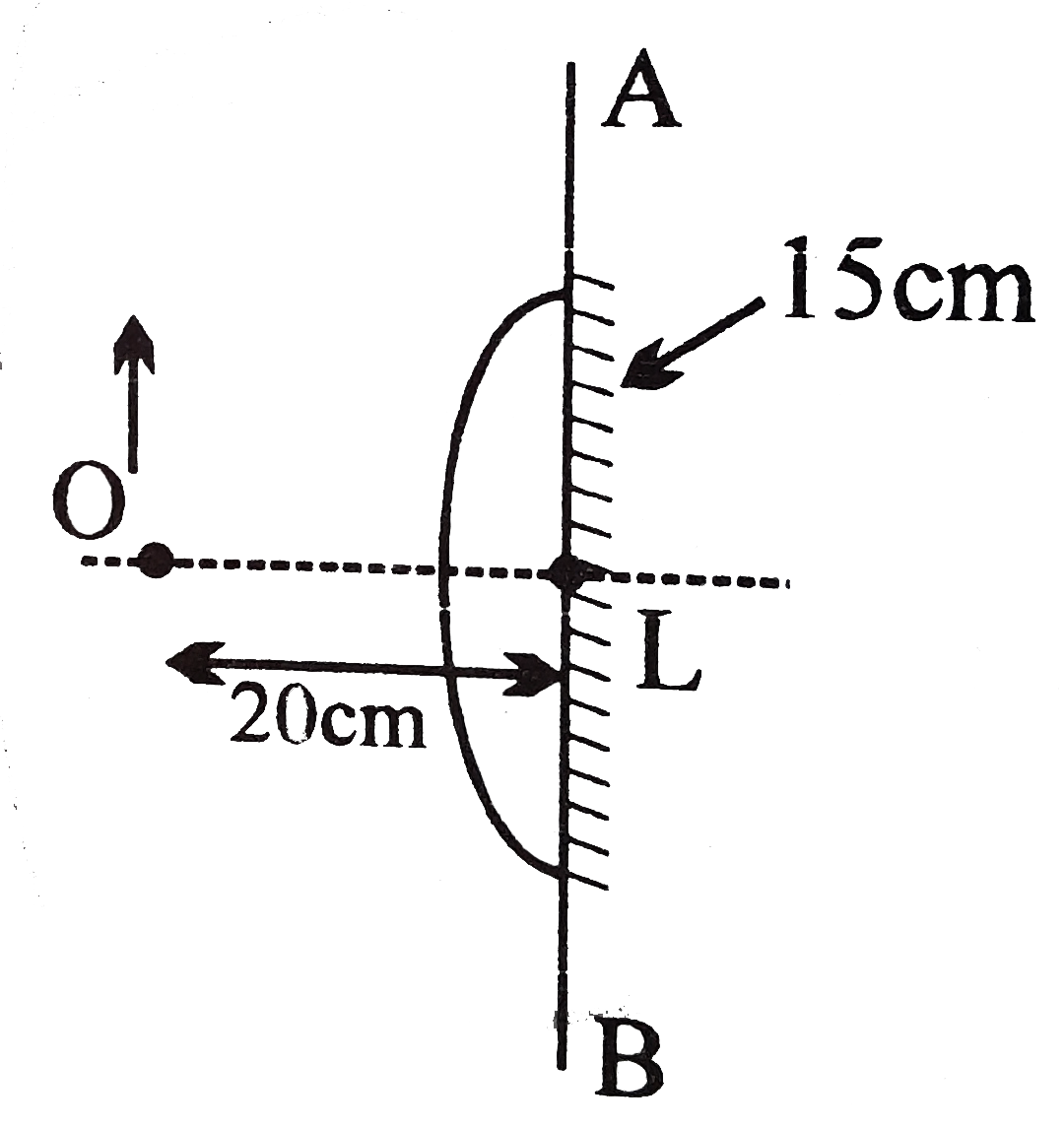There is a plano-convex lens whose radius of curvature for convex surface is 2.5 cm. Thickness of the lens is 9 cm. When object is placed at a certain distance from the convex surface then image is formed on the plane surface of the lens which serves as screen. What should be the magnification in this case? Refractive index is 1.5.
To solve the problem, we need to determine the magnification produced by a plano-convex lens when an object is placed in front of it. We will use the lens maker's formula and the magnification formula for lenses.
1. Identify the Given Values:
- Radius of curvature of the convex surface, R=2.5cm
- Thickness of the lens, d=9cm
- Refractive index of the lens, μ=1.5
- Refractive index of air, μ1=1
2. Use the Lens Formula:
The lens formula for a spherical surface is given by:
μ2v−μ1u=μ2−μ1R
Here, μ2=1.5 (for the lens), μ1=1 (for air), and R=2.5cm.
3. Substituting the Values into the Lens Formula:
1.5v−1u=1.5−12.5
Simplifying the right side:
1.5−12.5=0.52.5=15
So, we have:
1.5v−1u=15
4. Rearranging the Equation:
Rearranging gives us:
1.5v=1u+15
5. Finding a Common Denominator:
To combine the terms on the right side, we find a common denominator:
1u+15=5+u5u
Thus, we can write:
1.5v=5+u5u
6. Cross-Multiplying to Solve for v:
Cross-multiplying gives:
1.5⋅5u=v(5+u)
Simplifying:
7.5u=v(5+u)
7. Expressing v in terms of u:
Rearranging gives:
v=7.5u5+u
8. Calculating Magnification:
The magnification m is given by:
m=μ1vμ2u
Substituting μ1=1 and μ2=1.5:
m=v1.5u
Substitute v from the previous step:
m=7.5u1.5u(5+u)
Simplifying gives:
m=7.51.5(5+u)=55+u
9. Conclusion:
The magnification m will depend on the object distance u. Since the object is placed at a distance such that the image is formed on the plane surface, we can conclude that the magnification will be less than 1, indicating that the image is smaller and real.
Final Answer:
The magnification m is given by:
m=55+u
- Radius of curvature of the convex surface, R=2.5cm
- Thickness of the lens, d=9cm
- Refractive index of the lens, μ=1.5
- Refractive index of air, μ1=1
The lens formula for a spherical surface is given by:
μ2v−μ1u=μ2−μ1R
Here, μ2=1.5 (for the lens), μ1=1 (for air), and R=2.5cm.
1.5v−1u=1.5−12.5
Simplifying the right side:
1.5−12.5=0.52.5=15
So, we have:
1.5v−1u=15
Rearranging gives us:
1.5v=1u+15
To combine the terms on the right side, we find a common denominator:
1u+15=5+u5u
Thus, we can write:
1.5v=5+u5u
Cross-multiplying gives:
1.5⋅5u=v(5+u)
Simplifying:
7.5u=v(5+u)
Rearranging gives:
v=7.5u5+u
The magnification m is given by:
m=μ1vμ2u
Substituting μ1=1 and μ2=1.5:
m=v1.5u
Substitute v from the previous step:
m=7.5u1.5u(5+u)
Simplifying gives:
m=7.51.5(5+u)=55+u
The magnification m will depend on the object distance u. Since the object is placed at a distance such that the image is formed on the plane surface, we can conclude that the magnification will be less than 1, indicating that the image is smaller and real.
The magnification m is given by:
m=55+u
Topper's Solved these Questions
- BOOK - MODERN PUBLICATIONCHAPTER - RAY OPTICS AND OPTICAL INSTRUMENTSEXERCISE - NCERT FILE SOLVED (TEXT BOOK EXERCISES)38videos
RAY OPTICS AND OPTICAL INSTRUMENTS
- BOOK - MODERN PUBLICATIONCHAPTER - RAY OPTICS AND OPTICAL INSTRUMENTSEXERCISE - NCERT (EXemplar Problems Obejective Questions) (Multiple Choice Questions (Type-I)10videos
RAY OPTICS AND OPTICAL INSTRUMENTS
- BOOK - MODERN PUBLICATIONCHAPTER - RAY OPTICS AND OPTICAL INSTRUMENTSEXERCISE - Conceptual Questions40videos
RAY OPTICS AND OPTICAL INSTRUMENTS
- BOOK - MODERN PUBLICATIONCHAPTER - NUCLEIEXERCISE - CHAPTER PRACTICE TEST FOR BOARD EXAMINATION15videos
NUCLEI
- BOOK - MODERN PUBLICATIONCHAPTER - SEMICONDUCTOR ELECTRONICS METERIALS DEVICES AND SIMPLE CIRCUITS EXERCISE - CHAPTER PRACTICE TEST FOR BOARD EXAMINATION12videos
SEMICONDUCTOR ELECTRONICS METERIALS DEVICES AND SIMPLE CIRCUITS
Similar Questions
There is a glass (μ=1.5) biconvex lens of radius of curvature 5 cm and thickness of the lens is also 5 cm. An object is placed at a distance 20 cm from the front surface of lens. Locate its final image.
View SolutionA plano convex lens of radius of curvature 30 cm and refractive index 1.5 is kept in air. Find its focal length (in cm).
View Solution
Knowledge Check
- Question 1 - Select One
For a plano convex lens, the radius of curvature of convex surface is 10 cm and the focal length is 30 cm. The refractive index of the material of the lens is
A1.5B1.66C1.33D2.5 - Question 2 - Select One
If in a plano-convex lens, the radius of curvature of the convex surface is 10 cm and the focal length of the lens is 30 cm , then the refractive index of the material of lens will be
A1.5B1.66C1.33D3 - Question 3 - Select One
If in a plano-convex lens, the radius curvature of the convex surface is 10 cm and the focal length of the lens is 30 cm, then the refractive index of the material of lens will be
A1.5B1.66C1.33D3
If in a plano-convex lens, the radius curvature of the convex surface is 10 cm and the focal length of the lens is 20 cm , then the refractive index of the material of lens will be
View SolutionIf in a planoconvex lens, the radius of curvature of the convex surface is 10cm and the focal length is 30cm, the refractive index of the material of the lens will be
View SolutionIf in a plano-convex lens, the radius of curvature of the convex surface is 10 cm and the focal length of the lens is 30 cm , then the refractive index of the material of lens will be
View SolutionThe radius of curvature of the convex surface of a thin plano-convex lens is 15 cm and the refractive index of its material is 1.6. The power of the lens is
View SolutionA point object is placed at a distance of 20cm from a thin plano-convex lens of focal length 15cmIf the plane surface is silvered.the image will form at
 View Solution
View Solution

